#Luis Barta
Explore tagged Tumblr posts
Text
Rare footage of Conchita Supervía singing a Spanish song
This wonderful excerpt is taken from the 1934 film "Evensong'. Supervía sings "Los ojos negros" (Dark eyes) composed by Luis Barta.
#classical music#opera#music history#bel canto#composer#classical composer#aria#classical studies#maestro#chest voice#Los ojos negros#Dark eyes#Luis Barta#Evensong#Spanish song#Conchita Supervía#coloratura mezzo-soprano#mezzo-soprano#classical musician#classical musicians#classical history#opera history#history of music#history#historian of music#musician#muscians#diva#prima donna#Rare footage
6 notes
·
View notes
Text
Side by Side


Un Chien Andalou (1929) Luis Buñuel
The Vanished World of Gloves (1982) Jiří Barta
38 notes
·
View notes
Text

El vampiro de la autopista (1971) - German poster
AKA The Horrible Sexy Vampire
#el vampiro de la autopista#the horrible sexy vampire#wal davis#barta barri#anastasio campoy#1970s horror#1970s movies#1971#josé luis madrid#movie posters
36 notes
·
View notes
Text

BIOGRAPHIE DE SIMON GOULART
Simon Goulart, né à Senlis le 20 octobre 1543 et mort à Genève le 3 février 1628, est un théologien calviniste et un humaniste français.
Goulart étudie le droit à Paris. Ayant embrassé la religion réformée, il se réfugie, en mars 1566, à Genève, où il est reçu ministre du culte. En 1570, il épouse Suzanne Picot, puis il est admis gratuitement à la bourgeoisie de Genève. En 1589, il est aumônier des troupes genevoises pendant la guerre contre la Savoie.
En 1595, il prêche contre Henri IV. Il succède à Théodore de Bèze à la charge de modérateur de la Compagnie des pasteurs, de 1607 à 1612.
En 1602, lors de l’Escalade, il est pasteur du temple de Saint-Gervais, quartier situé sur la rive droite de Genève. Ayant exhorté les habitants de ce quartier-ci à prêter main-forte à leurs voisins d'en-face, il restera lui sur la rive droite pour soutenir par la prière la défense de la cité. En 1603, il rédige le Vray discours de la miraculeuse délivrance envoyée de Dieu à la ville de Genève, le 12 jour de décembre 1602, récit de l'attaque savoyarde.
Cet humaniste traduit Plutarque et Xénophon. Il rédige un Trésor d'histoires admirables et mémorables de notre temps (Genève, 1620), des Mémoires historiques sur la Ligue.
En 1580, il traduit l’Histoire de Portugal d’Osorius et de Fernão Lopes de Castanheda. L’épître dédicatoire à Nicolas Pithou commence ainsi :
« MONSIEUR, Je pense bien que ceux qui nous conoissent trouveront estrange et mal seant de prime face, que j’aye mis la main à ceste histoire, pour la communiquer à nostre nation : et qu’ayant esté dédiée par Osorius à un Prince, je la vous presente maintenant. Quant à ce premier point, je ne nie pas que durant le temps employé à ce labeur je pouvoy vacquer à choses plus serieuses, mieux convenantes à mes estudes, et plus propres à ma vocation. »
L'ouvrage a été écrit au « bourg de Sainct Gervais, le vingtiesme jour d’Octobre M.D.LXXX. » Depuis 1571, en effet, il est installé dans cette paroisse de Saint-Gervais, à Genève.
En 1581, il donne un Commentaire alphabétique (Indice) de la Sepmaine de Guillaume du Bartas qui est publié dans une édition augmentée du poète gascon. En 1589, chez le même éditeur (Jacques Chouet, Genève), il publie à nouveau ce commentaire, enrichi de remarques supplémentaires. De son côté, le catholique Pantaléon Thévenin commente lui aussi ce vaste poète encyclopédique.
De 1576 à 1597, il édite des chansons spirituelles et des psaumes de divers compositeurs chez divers imprimeurs de Lyon, Heidelberg ou Genève. Les chansons sont des chansons profanes dont le texte a été contrefait, c'est-à-dire remplacé par un texte spirituel plus à même d'être chanté dans les maisons calvinistes, et le principal compositeur mis à profit sera Orlande de Lassus. Ce faisant, il adopte la même démarche que Jean Pasquier, dont les éditions l'ont précédé à La Rochelle. Ces éditions contrefaites se font sans autorisation du compositeur, en dépit des privilèges accordés à Roland de Lassus par les rois de France, ceux-ci ne s'appliquant pas à Genève.
Goulart annote aussi le Grand Miroir du Monde du poète protestant Joseph Duchesne sieur de la Violette (1593). Goulart est également l'auteur d'Imitations chrestiennes. Selon Olivier Pot, Goulart envisageait l'existence d'une Académie littéraire protestante.
0 notes
Text
THE HORRIBLE SEXY VAMPIRE (1970) Reviews and overview
THE HORRIBLE SEXY VAMPIRE (1970) Reviews and overview
‘It’ll rock you in your seats!’ The Horrible Sexy Vampire is a 1970 Spanish horror film about an inhuman maniac that is murdering young women in Germany. Meanwhile, a doctor is convinced that the killings are the evil workings of a reclusive odd baron who died many years ago. Written and directed by José Luis Madrid (Seven Murders for Scotland Yard). The movie stars Waldemar Wohlfahrt [Wal…
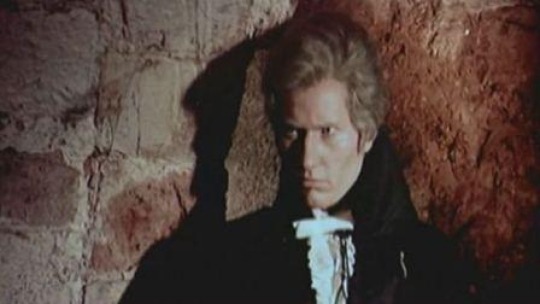
View On WordPress
#1970#Barta Barri#El vampiro de la autopista#film#horror#José Luis Madrid#movie#review reviews#Spanish#The Horrible Sexy Vampire#Wal Davis
1 note
·
View note
Text
brythonic deities + modern constellations
Abela Abeles Abella Abnoros Abus Abux Abuxena Abuxovis Adorvo Adra Adsus Aelia Agium Agranor Agros Agruxenus Agunnus Alatorita Alaus Alis Alisa Amindus Amna Amoscurus Ampes Ancangus Ancankou Ancenus Ancerius Ancetou Andor Anduis Andus Anetaunus Anexta Angus Ania Anis Anium Anor Anos Ansa Anta Antia Antios Anunnus Anus Apon Aponus Aprio Apuppis Apupus Aquaritta Aquilanor Aquilatis Aquis Aquulugus Aquulum Arabusa Arabux Arassios Arasusis Arauratum Ardus Ariestris Aris Arius Arna Arnate Arus Atus Aunnus Aunus Aurseus Aveniscon Avensagus Avenus Averia Avete Avetela Avetios Avoluis Avos Banos Banus Barnus Barta Bela Belancer Belaniae Belanix Belans Belis Bellis Bello Bellos Bellus Belo Belpeiani Belpes Bornesuca Borolatia Boros Borpes Boöte Boötepus Boöteris Braces Bracopis Bria Brians Bricinos Briciros Bries Brigassio Brigasus Brionnos Brioviria Bris Brismello Brittani Brius Cador Cadrannor Cadroba Cadsucae Camba Camicra Campega Camula Cana Cancania Cancankou Candamna Candronus Canes Canescor Cangus Cani Cania Cankou Canoscer Cans Cansagus Canta Canus Capona Caponus Capus Carana Caratobis Carus Cassio Casta Caste Cens Ceria Cericta Ceriga Ceris Cernus Cetasgus Cetepon Ceteron Cetio Cetucanes Chama Chamajor Chus Cicor Cicra Cimba Cimbarius Cimbius Cimbrans Cinus Cirgo Ciumba Cius Clogmina Clopium Clos Clotardus Cocernus Cola Colo Comarus Como Conius Conus Coparna Copega Copens Copessis Cornus Corrudius Corrus Covius Crasta Croboöte Crolupus Crus Crusus Dantinos Darnus Datiopium Delena Deleus Dens Denus Dranor Drus Drux Equardus Equulum Ernus Erseus Fagitta Fagius Fanetuta Forvolo Gema Gemelos Geminius Gemioni Gronax Gros Grota Grumbris Heta Hoens Hoenus Horvo Huetaurus Huete Huetes Huetonis Huetoutus Husus Hydradra Hydros Hydrotor Indarus Inobor Inos Inotou Inotum Intara Inus Iovana Iovis Laurus Lenia Lenis Lentia Leona Leoni Lesco Lessionia Leus Liovens Lisantlis Lisus Luila Luis Lumbardus Lumbis Lumbriona Luppius Lusamo Lyraba Lyrador Lyraura Maer Major Maprios Meleus Melum Minnus Mintritta Minus Mion Mogita Mogminor Mona Monata Mondara Monnisus Monus Musagrus Nemetepus Nemina Neria Neterios Nobis Nobius Nodella Noritios Norpenus Norrus Norvus Noscornus Notanna Ocelum Ocentico Ocimbanes Ocirium Octasgus Ogmina Oguns Ogus Oparinus Opecura Opheus Ophoenta Opium Opius Orna Orrudium Para Parduis Parium Parus Parux Parvusus Paventhus Pavenus Pavetis Peculenus Pego Pegus Pentio Perpeia Pertinus Pertrebis Phetans Phium Phoenus Pium Pius Puppius Pupus Rebis Rebiuca Rebius Rete Rollo Rosedatia Rota Rotum Ruxena Sagium Sagrata Sagrus Saguluis Samarus Sancangus Sancapus Santianus Sanusus Scamio Scarnus Scer Scopavos Sculeus Sculum Scuta Scutia Seda Sega Sego Segus Sernus Seus Sextanus Sextio Smedannus Smelio Smerseros Sminos Sminus Sucannus Sucetios Tandans Tangus Tanis Tanus Tatictoba Tauriga Taus Tepon Teries Tesus Tobor Tormapon Torveriae Toutis Trebis Tridium Triga Trigasgus Trinus Tris Trius Urado Uraus Uritta Ursa Urum Urus Urusio Venix Vens Venus Veternus Vetios Vher Vherio Vhertania Vhertis Vheus Vina Vindatum Vindorrus Vinia Vinnos Vinocici Vinosego Vinus Vircis Viria Virius Virolum Visa Visagunus Vitarvo Vitia Vitta Vium Vius Volator Vollos Volo Volus
3 notes
·
View notes
Text
Mahakala omnogovae

By Ripley Cook
Etymology: Named for Mahakala, one of the eight protector deities of Tibetan Buddhism
First Described By: Turner et al., 2007
Classification: Dinosauromorpha, Dinosauriformes, Dracohors, Dinosauria, Saurischia, Eusaurischia, Theropoda, Neotheropoda, Averostra, Tetanurae, Orionides, Avetheropoda, Coelurosauria, Tyrannoraptora, Maniraptoromorpha, Maniraptoriformes, Maniraptora, Pennaraptora, Paraves, Eumaniraptora, Dromaeosauridae, Halszkaraptorinae
Status: Extinct
Time and Place: 80 million years ago, in the Campanian of the Late Cretaceous


Mahakala is known from the Tögrögiin Shiree of the Djadokhta Formation in Ömnögovi, Mongolia
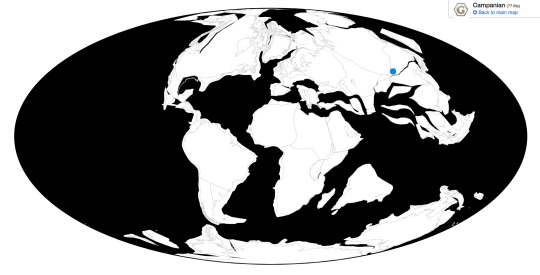
Physical Description: Mahakala was a small raptor, about 70 centimeters in length, and it was very similar to the earliest members of the Eumaniraptoran group in general, sharing characteristics with other Eumaniraptorans like Troodontids and Avialans. Mahakala was also a Halszkaraptorine, a group of weird little raptors with a semiaquatic lifestyle. It is uncertain if Mahakala was semiaquatic, but it seems at least possible at this time. Like other raptors, it had a sickle claw on its second toe, and like Troodontids and Avialans, it had an extended third foot bone. It also had very short forelimbs compared to other raptors, but similar in size to those of Halszkaraptor. In Halszkaraptor, the forelimbs are adapted to form flippers, like that of a cormorant. While the wings of Mahakala aren’t quite to that extent, it’s possible that it was a transitional form, or had partly aquatically adapted forelimbs. As a raptor, Mahakala would have been covered in feathers, with wings on its arms and a tail fan on its tail.
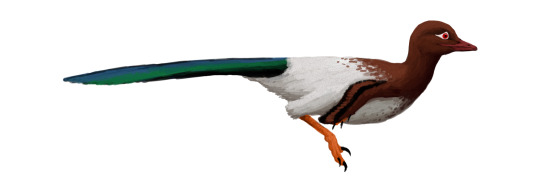
By Ashley Patch
Diet: If Mahakala was like its close relative Halszkaraptor and associated with the water found in its environment, it would have most likely been a piscivore.
Behavior: Mahakala probably spent most of its time in or near sources of water, which were a tad hard to come by in its very arid environment. As such, it probably didn’t move about much, but spent its time at the oases and temporary rivers to find food in the water. It probably also swam about in the water, using its wings and legs to help propel it forward. It would have been a secretive sort of animal, being surrounded by many kinds of predators and threats, and wouldn’t have strayed far from its home. Given its rarity, and the uncommon nature of its probable preferred habitat, Mahakala would have probably not lived in social groups. However, it most likely took care of its young in some form.
Ecosystem: The Djadochta Formation was an arid desert environment, with red sand and dirt for miles and very little water for Mahakala to associate with. That being said, there were a decent number of oases in the environment, and temporary rivers called arroyos that would pop up during the wet season. Thus, Mahakala would have been mostly associated with the oases. Because of the red coloration of the ground (giving this area today the name of the Flaming Cliffs), most of the animals in the area would have actually been quite red or reddish, in order to blend in. In the oasis areas where Mahakala would have been found, there were probably horsetails and other water plants, rather than the dry shrubs and arid foliage found elsewhere in the environment. The Tögrögiin environment was not as diverse as the later Ukhaa Tolgod, but was still filled with a variety of animals. Here there were mammals such as Zalambdalestes, Kryptobaatar, and Barunlestes; lizards like Cherminotus, Adamisaurus, Temujinia, Zapsosaurus, Mimeosaurus, Flaviagama, Gurvansaurus, Dzhadochtosaurus, and Isodontosaurus; and other small animals. As for other dinosaurs, there was the Ankylosaur Pinacosaurus, the ceratopsian Protoceratops, the alvarezsaur Parvicursor (and possibly Shuvuuia), the ornithomimosaur Aepyornithomimus, and the raptor Velociraptor. In short, this was an exceptionally fluffy land indeed!
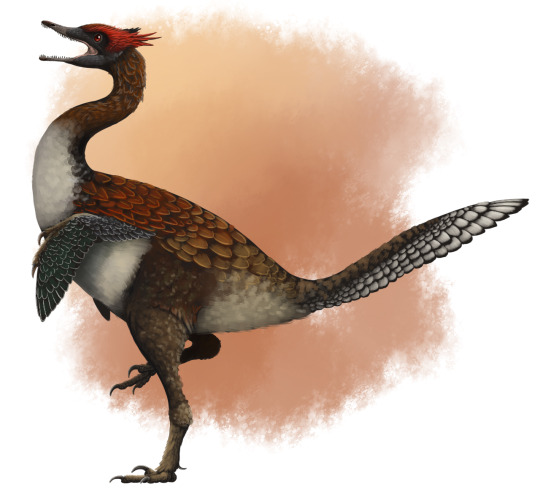
By Scott Reid
Other: It is interesting to note that Mahakala and Halszkaraptor not only are shown as closely related in phylogenetic analyses since the latter was described, but that Mahakala actually comes from the same, but earlier environment, as Halszkaraptor. It is entirely possible, therefore, that Mahakala is actually the ancestor of Halszkaraptor, with other members of this weird raptor group splitting off at around the same time as Mahakala began that transition. This is not directly found in studies yet, however, so take that hypothesis with a grain of salt. Regardless, Mahakala was a very basal raptor, and even though it lived late in the fossil record in the group - at a time when many later-derived forms were very common - it still had many similarities to the Troodontids and the Avialans in addition to the raptors.
~ By Meig Dickson
Sources under the Cut
Cau, A., V. Beyrand, D. F. A. E. Voeten, V. Fernandez, P. Tafforeau, K. Stein, R. Barsbold, K. Tsogtbaatar, P. J. Currie, P. Godefroit. 2017. Synchrotron scanning reveals amphibious ecomorphology in a new clade of bird-like dinosaurs. Nature 552: 395 - 399.
Cau, A., and D. Madzia. 2018. Redescription and affinities of Hulsanpes perlei (Dinosauria, Theropoda) from the Upper Cretaceous of Mongolia. PeerJ 6:e4868:1-19
Chinzorig Tsogtbaatar; Yoshitsugu Kobayashi; Tsogtbaatar Khishigjav; Philip J. Currie; Mahito Watabe; Barsbold Rinchen (2017). “First Ornithomimid (Theropoda, Ornithomimosauria) from the Upper Cretaceous Djadokhta Formation of Tögrögiin Shiree, Mongolia”. Scientific Reports. 7: Article number 5835.
Clarke, Julia A., Norell, Mark A. (2002). “The morphology and phylogenetic position of Apsaravis ukhaana from the Late Cretaceous of Mongolia”. American Museum Novitates, No. 3387, American Museum of Natural History, New York, NY.
Delcourt, R., and O. N. Grillo. 2014. On maniraptoran material (Dinosauria: Theropoda) from Vale do Rio do Peixe Formation, Bauru Group, Brazil. Revista Brasileira de Paleontologia 17(3):307-316
Gianechini, F. A., P. J. Makovicky, and S. Apesteguía. 2017. The cranial osteology of Buitreraptor gonzalezorum Makovicky, ApesteguÍa, and AgnolÍn, 2005 (Theropoda, Dromaeosauridae), from the Late Cretaceous of Patagonia, Argentina. Journal of Vertebrate Paleontology 27(1):e1255639:1-19
Godefroit, Pascal; Currie, Philip J.; Li, Hong; Shang, Chang Yong; Dong, Zhi-ming (2008). “A new species of Velociraptor (Dinosauria: Dromaeosauridae) from the Upper Cretaceous of northern China”. Journal of Vertebrate Paleontology. 28 (2): 432–438.
Hartman, S., M. Mortimer, W. R. Wahl, D. R. Lomax, J. Lippincott, D. M. Lovelace. 2019. A new paravian dinosaur from the Late Jurassic of North America supports a late acquisition of avian flight. PeerJ: e7247.
Jerzykiewicz, Tom (1997). "Djadokhta Formation". In Currie, Phillip J.; Padian, Kevin (eds.). Encyclopedia of Dinosaurs. San Diego: Academic Press. pp. 188–191.
Junchang Lü; Li Xu; Yongqing Liu; Xingliao Zhang; Songhai Jia & Qiang Ji (2010). “A new troodontid (Theropoda: Troodontidae) from the Late Cretaceous of central China, and the radiation of Asian troodontids”. Acta Palaeontologica Polonica. 55 (3): 381–388.
Ksepka, Daniel T.; Norell, Mark A. (2004). “Ornithomimosauria cranial material from Ukhaa Tolgod (Omnogov, Mongolia)”. American Museum Novitates. 3448: 1–4.
Longrich, N. R., and P. J. Currie. 2009. A microraptorine (Dinosauria–Dromaeosauridae) from the Late Cretaceous of North America. Proceedings of the National Academy of Sciences 106 (13): 5002 - 5007.
Longrich, N. R., P. J. Currie, and Z.-M. Dong. 2010. A new oviraptorid (Dinosauria: Theropoda) from the Upper Cretaceous of Bayan Mandahu, Inner Mongolia. Palaeontology 53(5):945-960
Montague, R. (2006). “Estimates of body size and geological time of origin for 612 dinosaur genera (Saurischia, Ornithischia)”. Florida Scientist. 69 (4): 243–257.
Nesbitt, S. J., J. A. Clarke, A. H. Turner and M. A. Norell. 2011. A small alvarezsaurid from the Eastern Gobi Desert offers insight into evolutionary patterns in the Alvarezsauroidea. Journal of Vertebrate Paleontology 31(1):144-153
Norell, Mark A.; Clark, James M.; Dashzeveg, Demberelyin; Barsbold, Rhinchen; Chiappe, Luis M.; Davidson, Amy R.; McKenna, Malcolm C.; Perle, Altangerel; Novacek, Michael J. (November 4, 1994). “A theropod dinosaur embryo and the affinities of the Flaming Cliffs dinosaur eggs”. Science. 266 (5186): 779–782.
Norell, M.A.; Clark, J.M.; Turner, A.H.; Makovicky, P.J.; Barsbold, R.; Rowe, T. (2006). “A new dromaeosaurid theropod from Ukhaa Tolgod (Omnogov, Mongolia)”. American Museum Novitates. 3545: 1–51.
Norell, M.A., Makovicky, P.J. & Clark, J.M., 2000, “A new troodontid theropod from Ukhaa Tolgod, Mongolia”, Journal of Vertebrate Paleontology 20(1): 7-11
Novacek, M.J., Norell, M.A, McKenna, M.C. and Clark, J.M, 1994, “Fossils of the Flaming Cliffs”, Scientific American 271(6), 60-69
Pei, R., Q. Li, Q. Meng, K.-Q. Gao, and M. A. Norell. 2014. A New Specimen of Microraptor (Theropoda: Dromaeosauridae) from the Lower Cretaceous of Western Liaoning, China. American Museum Novitates 3821:1-28
Prieto-Marquez, A., M. Bolortsetseg, and J. R. Horner. 2012. A diminutive deinonychosaur (Dinosauria: Theropoda) from the Early Cretaceous of Oosh (Ovorkhangai, Mongolia). Alcheringa 36(1):117-136
Turner, A. H., D. Pol, J. A. Clarke, G. M. Erickson, and M. A. Norell. 2007. A basal dromaeosaurid and size evolution preceding avian flight. Science 317:1378-1381
Turner, A.H.; Nesbitt, S.J.; Norell, M.A. (2009). “A Large Alvarezsaurid from the Cretaceous of Mongolia”. American Museum Novitates. 3648: 1–14.
Varricchio, D.J.; Barta, D.E. (2015). “Revisiting Sabath’s "Larger Avian Eggs” from the Gobi Cretaceous". Acta Palaeontologica Polonica. 60 (1): 11–25.
Weishampel, David B.; Dodson, Peter; and Osmólska, Halszka (eds.): The Dinosauria, 2nd, Berkeley: University of California Press. 861 pp.
Williamson, T. E., and S. L. Brusatte. 2014. Small theropod teeth from the Late Cretaceous of the San Juan Basin, northwestern New Mexico and their implications for understanding latest Cretaceous dinosaur evolution. PLoS ONE 9(4):e93190:1-23
#Mahakala#Mahakala omnogovae#Raptor#Dromaeosaur#Dinosaur#Bird#feathered dinosaur#Birds#Dinosaurs#Birblr#Palaeoblr#Factfile#Piscivore#Theropod Thursday#Eurasia#Cretaceous#paleontology#prehistory#prehistoric life#biology#a dinosaur a day#a-dinosaur-a-day#dinosaur of the day#dinosaur-of-the-day#science#nature
210 notes
·
View notes
Text
World Poll 2019
Great recent movies (made since 2014) seen for the first time in 2019
Mademoiselle de Joncquières (Emmanuel Mouret, 2018)
Dau Huduni Methai (Song of the Horned Owl, Manju Borah, 2015)
El Crack cero (José Luis Garci, 2019)
Jiang hu er nv (Ash is Purest White, Jia Zhang-ke, 2018)
Carré 35 (Plot 35, Éric Caravaca, 2017)
Sic transit Gloria Mundi (Gloria Mundi, Robert Guédiguian, 2019)
If Beale Street Could Talk (Barry Jenkins, 2018)
Ad Astra (James Gray, 2019)
Le Chant du loup (The Wolf’s Call, Antonin Braudy, 2019)
Shooting the Mafia (Kim Longinotto, 2019)
Village Rockstars (Rima Das, 2017)
Tantas Almas (Valley of Souls, Nicolás Rincón Gille, 2019)
Un peuple et son roi (Pierre Schoeller, 2018)
Aamis (Ravening, Bhaskar Hazarika, 2018/9)
Fishbone (Adán Aliaga, 2018)
O que arde (Fire Will Come, Oliver Laxe, 2019)
La Fin de la nuit (Lucas Belvaux, 2015)
Ramen Teh (Ramen Shop, Eric Khoo, 2018)
Light of My Life (Casey Affleck, 2019)
Great movies (made before 2014) seen for the first time in 2019
’49-’17 (Ruth Ann Baldwin, 1917)
Ba shan ye yu (Evening Rain / Night Rain of Mount Ba, Wu Yigong and Wu Yonggang, 1980)
The Spirit of the Flag (Allan Dwan, 1913)
Versailles (Pierre Schoeller, 2008)
Ùn pienghjite mica (Les Anonymes, Pierre Schoeller, 2012/3)
Foxfire (Joseph Pevney, 1954/5)
Johnny Come Lately (William K. Howard, 1943)
I girovaghi (Hugo Fregonese, 1956)
Nunal sa Tubig (Speck in the Water, Ishmael Bernal, 1976)
Ikaw ay Kin (You Are Mine, Ishmael Bernal, 1978)
Pervyí eshielon (The First Convoy, Mikhail Kalatozov, 1955/6)
The Sea Wolf (Alfred Santell, 1930)
Surrender (William K. Howard, 1931)
The Restless Years (Helmut Käutner, 1958)
Darling, How Could You! (Mitchell Leisen, 1951)
Ko:Yad (A Silent Way, Manju Borah, 2012)
The Flame (John H. Auer, 1947)
Ernst Thälmann-Sohn seiner Klasse (Kurt Maetzig, 1954)
Ernst Thälmann-Führer seiner Klasse (Kurt Maetzig, 1955)
Bólshaia Sémia (A Big Family, Iosif Kheífits, 1954)
Circuit Carole (Emmanuelle Cuau, 1995)
Harvey (Henry Koster, 1950)
As It Is in Life (D.W. Griffith, 1910)
Abroad with Two Yanks (Allan Dwan, 1944)
Behind Office Doors (Melville W. Brown, 1931)
Lovin’ The Ladies (Melville W. Brown, 1930)
La Tarea o cómo la pornografía salvó del tedio y mejoró la economía de la familia Partida (Homework, Jaime Humberto Hermosillo, 1990/1)
A Modern Hero (G.W. Pabst, 1934)
Surrender (William K. Howard, 1931)
Jubilee Trail (Joseph Inman Kane, 1954)
Matinée (Jaime Humberto Hermosillo, 1976/7)
Linda (Mrs. Wallace Reid = Dorothy Davenport, 1928/9)
Die missbrauchten Lebesbriefe (Leopold Lindtberg, 1940)
Very good movies (made since 2014) seen for the first time in 2019
Photograph (Ritesh Batra, 2019)
The Mule (Clint Eastwood, 2018)
The Man Who Killed Hitler and Then The Bigfoot (Robert D. Krzykowski, 2018)
Frères ennemis (Close Enemies, David Oelhoffen, 2018)
L’Homme fidèle (A Faithful Man, Louis Garrel, 2018)
Pris de court (Not on My Watch, Emmanuelle Cuau, 2016)
Dolor y Gloria (Pain and Glory, Pedro Almodóvar, 2019)
Frost (Šerkšnas, Sharunas Bartas, 2017)
Vitalina Varela (Pedro Costa, 2019)
Da xiang xi di er zuo (An Elephant Sitting Still, Hu Bo, 2018)
Di qiu zui hou de ye wan (Long Day’s Journey Into Night, Bi Gan, 2018)
La Tenerezza (Tenderness, Gianni Amelio, 2017)
Fourteen (Dan Sallitt, 2019)
Bulbul Can Sing (Rima Das, 2018)
A Rainy Day in New York (Woody Allen, 2019)
Legado en los huesos (Fernando González Molina, 2019)
Ma vie dans l’Allemagne d’Hitler (My Life in Hitler’s Germany, Jérôme Prieur, 2018)
La Vie balagan de Marceline Loridan-Ivens (Yves Jeuland, 2018)
Gangbyeon Hotel (Hotel by the River, Hong Sang-soo, 2018)
The Wind (Emma Tammi, 2018)
Kothanodi (The River of Fables, Bhaskar Hazarika, 2015)
Dar Jostojoy-e Farideh (Finding Farideh, Azadeh Moussavi & Kourosh Ataee, 2018)
Sir (Rohena Gera, 2018)
El Proyeccionista (The Projectionist, José María Cabral, 2019)
Intemperie (Benito Zambrano, 2019)
Madre (Mother, Rodrigo Sorogoyen, 2017, short)
Three Identical Strangers (Tim Wardle, 2018)
Madre (Rodrigo Sorogoyen, 2019)
Very good movies (made before 2014) seen for the first time in 2019
A Life for a Kiss (Allan Dwan, 1912)
Futari de aruita iku haru aki (The Days We Spent Together, Kinoshita Keisukē, 1962)
The Necklace (D.W. Griffith, 1909)
Das Schiff der verlorenen Menschen (Ship of Lost Men, Maurice Tourneur, 1929)
The Broken Locket (D.W. Griffith, 1909)
Primrose Hill (Mikhaël Hers, 2007)
The Rejected Woman (Albert Parker, 1924)
El último malón (Alcides Greca, 1917)
Bullets for O’Hara (William K. Howard, 1941)
Le Récit de Rebecca (Paul Vecchiali, 1964)
La noche avanza (Night Falls, Roberto Gavaldón, 1952)
Over-Exposed (Lewis B. Seiler, 1956)
I rollerna tre (Christina Olofson, 1996)
Il Viale della Speranza (Dino Risi, 1953)
Because of You (Joseph Pevney, 1952)
1870/…Correva l’anno di grazia 1870 (Alfredo Giannetti, 1972)
Demi-tarif (Isild Le Besco, 2003)
L’Exercice de l’État (The Minister, Pierre Schoeller, 2011)
Cheng nan jiu shi (My Memories of Old Beijing / Old Stories of the Southern Part of the City, Wu Yigong, 1983)
Strangler of the Swamp (Frank Wisbar, 1945/6)
Sword in the Desert (George Sherman, 1949)
There’s Always Tomorrow (Too Late For Love;Edward Sloman, 1934)
East Side, West Side (Allan Dwan, 1927)
Le Départ (Damien de Pierpont, 1998)
Face aux fantômes (Jean-Louis Comolli, 2009)
The Eagle and the Hawk (Mitchell Leisen, credited to Stuart Walker, 1933)
Whirlpool (Roy William Neill, 1934)
The Animal Kingdom (Edgard H. Griffith; uc. George Cukor, 1932)
Le Passager (The Passenger, Éric Caravaca, 2005)
Razumov (Sous les yeux d’Occident) (Marc Allégret, 1936)
Banjo On My Knee (John Cromwell, 1936)
One Night of Love (Victor Schertzinger, 1934)
Enchantment (Robert G. Vignola, 1921)
Charell (Mikhaël Hers, 2006)
Men With Wings (William A. Wellman, 1938)
Delitto per amore (L’edera) (Augusto Genina, 1950)
Les Amants de Minuit/Les Amours de Minuit (Augusto Genina, 1930/1)
Human Cargo (Allan Dwan, 1936)
Up the Ladder (Edward Sloman, 1925)
Luxury Liner (Richard B. Whorf, 1948)
Surrender! (Edward Sloman, 1927)
The Judge (Elmer Clifton, 1948/9)
Turbión (Antonio Momplet, 1938)
Der Ruf (Josef von Báky, 1949)
Faubourg Montmartre (Raymond Bernard, 1931)
Träumerei (Harald Braun, 1944)
The Red Lantern (Albert Capellani, 1919)
El Paseíllo (Ana Mariscal, 1968)
La quiniela (Ana Mariscal, 1960)
Great movies growing up or just rediscovered in 2019
Letter of Introduction (John M. Stahl, 1938)
Only Yesterday (John M. Stahl, 1933)
Our Wife (John M. Stahl, 1941)
Wohin und zurück (Axel Corti, 1982-6)
Giorno per giorno, disperatamente (Alfredo Gianetti, 1961)
Die wunderbare Lüge der Nina Petrowna (Hanns Schwarz, 1929)
Alyonka (Boris Barnet, 1961)
Craig’s Wife (Dorothy Arzner, 1936)
Imitation of Life/Fannie Hurst’s “Imitation of Life” (John M. Stahl, 1934)
Captains Courageous (Victor Fleming, 1937)
Test Pilot (Victor Fleming, 1938)
The Eternal Sea (John H. Auer, 1955)
Hello, Sister! (Anonymous: Erich von Stroheim, Alfred L. Werker, Raoul Walsh, Alan Crosland, 1933)
La noche de enfrente (Night Across the Street, Raúl Ruiz, 2012)
Journey into Light (Stuart R. Heisler, 1951)
Feel My Pulse (Gregory LaCava, 1928)
La signora senza camelie (The Lady Without Camelias, Michelangelo Antonioni, 1953)
Nosotros que fuimos tan felices (Antonio Drove, 1976)
Very good movies improved
Liana (Boris Barnet, 1955)
L’Avventura (Michelangelo Antonioni, 1960)
Du haut en bas (High and Low, G.W. Pabst, 1933)
Amok (Antonio Momplet, 1944)
The Man Who Never Was (Ronald Neame, 1956)
Open Range (Kevin Costner, 2003)
Con la vida hicieron fuego (Ana Mariscal, 1959)
Timberjack (Joe Kane, 1954/5)
En la Palma de tu Mano (Roberto Gavaldón, 1951)
Gravity (Alfonso Cuarón, 2013)
Expreso de Andalucía (Francisco Rovira-Beleta, 1956)
El Camino (Ana Mariscal, 1963)
La viuda del capitán Estrada (José Luis Cuerda, 1991)
Vestida de azul (Antonio Giménez-Rico, 1983)
Segundo López aventurero urbano (Ana Mariscal, 1953)
Hell’s Outpost (Joe Kane, 1954)
Fuente: http://sensesofcinema.com/2020/world-poll/world-poll-2019-part-5/#4
3 notes
·
View notes
Text
Lionel Messi and FC Barcelona Oneshot
Anon requested a cute fic about Leo and the team (we all know they are one big family), so I decided on this scenario. I’m not sure if I am right about all the players still being there but I really want them to be so yeah, I hope you enjoy <3
Leo goes to training for the first time after losing the world cup in Brazil. The team is there to support him.
Leo’s late to training for the first time in his life.
When his car rolls into the parking space his usual spot is already occupied by Neymar’s shiny new Porsche. On other days Leo maybe would have been mad but right now he’s just too tired to feel anything. He parks a few meters down and continues sitting in his seat until the clock on his dashboard tells him he is now officially fifteen minutes late.
He should probably get out and apologize to Enrique but he doesn’t really want to. La Liga starts again next week and the first training session after a big tournament is always the hardest, especially after you’ve lost said big tournament.
Leo sighs deeply and finally opens the door of his car, slipping out into the warm morning. He gets his bag out of the trunk and then slowly makes his way towards the doors of the trainings center.
His steps are heavy, his shoulder slumped forward. He’s so tired and the prospect of having to start playing soccer again makes him want to turn around and drive back home. Leo has always loved playing soccer, it was his escape, his second reality but now, after that world cup, he, for the first time in his life, feels like he wants to quit.
Leo’s in the corridor leading to their locker room by now. He checks his phone, another five minutes have passed, his teammates should be on the pitch by now. He slings his bag over his shoulder, pushes the door open with a heavy sigh and halts midway through, petrified.
The locker room is not empty like he originally suspected, no, it’s actually crowded. The whole team is there, all dressed in their gears but none of them look like they’re about to get up and join Enrique, who is probably already waiting for them, on the field. They’re waiting for him, all of them.
Something inside of Leo snaps and he tightens his grip around the strap of his bag. Those past few days he has spent the majority of his time sleeping and trying to forget what happened to him in Brazil. At some point he actually got it to stop hurting and now the memory is only a dull throbbing in the back of his skull, that Leo is trying to live with.
But having all of his teammates waiting for him, his friends and also his family, he suddenly starts hurting all over again.
“What are you all doing here?” He asks, wanting to sound angry but ending up sounding broken.
He doesn’t wait for any of them to answer and walks over to his bench, sitting down and letting his bag hit the ground with a thud.
“Are you not happy to see us?”
Geri’s deep voice is so familiar that it eases Leo’s irritation immediately. He bends down and unties his shoes, trying to breathe evenly and calm his racing heart.
“I am.” He says and as soon as those words leave his mouth he knows he’s not lying. “I’m very happy to see you.”
Gerard squats so he can look Leo in the eyes when he glances back up.
“We’re happy to see you too.” The Spaniard says, his face breaking out into one of those dumb grins. “We already thought our captain would miss the first training of the season. We want to kick ass but we can’t do that without you.”
Leo holds Gerard’s crystal blue eyes for a moment and slowly but surely the uneasy feeling that had been pooling in the pit of his stomach starts to fade away.
He’s about to open his mouth and say something along the lines of that he’s not sure if he would be able to lead Barcelona to victory this year but before he has the chance to get anything out, Neymar plops down next to him, almost sitting down on his lap.
He’s not wearing his gear but normal clothes instead, Leo can see the outlines of a corset through his thin t-shirt and suddenly he feels bad for not asking Ney how he was when he called him after the final. Leo had been too wrapped up in his own problems to realize that he was not the only one hurting.
“Ney.” He breathes and reaches up to affectionately brush a hand through his hair. “How are you, how’s your back?”
Neymar purrs and nuzzles against his hand a bit.
“I’m good, I’m good, still walking.” He says. “I made you mate.”
Leo looks down, surprise written all over his face and hears a low laugh rumble through his teams.
“Did you now?” He mumbles and takes the cup from Neymar, smiling gratefully.
He brings it to his lips, takes a long sip and sighs when the familiar taste spreads through his mouth.
“Everytime we tried talking to you, you said you were tired.” Neymar babbles on. “So we decided to make you mate.”
“We?”
“Luis helped. He knows the way you like it best.”
Leo’s eyes search for Luis and find him standing next to Geri.
“You always get grumpy when you don’t drink mate.” He comments and walks over to where Leo is sitting, wrapping an arm around his shoulder. “How are you doing?”
“I’m good.” The Argentinian says and drinks again.
He can feel his body slowly coming back to life, his mind clearing, his tiredness fading. He’s amazed how easily his teammates can make him feel better, lifting a weight of his shoulder that had been crushing him since the final whistle blew in the Maracanã stadium. It’s then that Leo realizes that they know how he’s feeling. Neymar, Luis, Geri, Dani and Masche, who had suffered alongside him. He’s not alone in this and somehow that makes everything so much better.
“That’s a lie. That you’re good, I mean.” Geri chirps playfully. “But that’s okay; we will nurse you back to being confident.”
He ruffles Leo’s hair gently and then the smaller man gets up and wraps his arms around Geri’s giant frame. They hug tightly and when Leo mumbles a soft “thank you” into the giant’s chest, Geri pats his head awkwardly.
“There, there.” He says before separating Leo from him again. “You will be okay, go hug Ney now, he has been longing to hug you since he got injured.”
Leo doesn’t even comment on that, just twists around and walks over to Neymar who happily takes him into his arms.
“Thank you.” He says again and Neymar squeezes him so hard he has trouble breathing for a moment.
“You’re still the best in the world.” The Brazilian says and then. “Ouch, be careful with my back.”
Leo shifts his arms upwards but doesn’t let go off his friend until their whole team crowds around them, joining in on their hug. Soon everybody is chatting like they normally do, the only thing different is that Leo is being passed around the locker room, talking to everybody who had patiently waited for him.
Dani covers his face in little encouraging kisses, he hugs Cesc tightly and lets the Spaniard tell him a few horrible jokes before Iniesta comes to steal him away. Puyol invites him for dinner and then squeezes his shoulder tightly, Masche and him have a short but meaningful conversation and when he reaches Marc Barta the young player starts showing him a compilation of Leo’s best goals.
“You’re the king.” He says when it finishes.
And when Enrique eventually comes to yell at them to get their asses out on the field and everybody scurries out quickly, Leo feels light again.
#lionel messi#neymar#luis suarez#gerard piqué#marc barta#andres iniesta#carles puyol#iniesta#cesc fabregas#fc barcelona#fc barcelona imagine#soccer imagine#fluuuuuuff
7 notes
·
View notes
Photo

My fav films of the 00s:
Sang sattawat, Apichatpong Weerasethakul, 2006
Mulholland Drive, David Lynch, 2001
Elephant, Gus Van Sant, 2003
La Pianiste, Michael Haneke, 2001
Melancholia, Lav Diaz, 2006
Juventude Em Marcha, Pedro Costa, 2006
Sen to Chihiro no kamikakushi, Hayao Miyazaki, 2001
Stellet Licht, Carlos Reygadas, 2007
Dogville, Lars von Trier, 2003
Les jours où je n'existe pas, Jean-Charles Fitoussi, 2002
Werckmeister harmóniák, Béla Tarr, Ágnes Hranitzky, 2000
Freedom, Šarūnas Bartas, 2000
Los muertos, Lisandro Alonso, 2004
Yi yi, Edward Yang, 2000
Ni na bian ji dian, Tsai Ming-liang, 2001
Faa yeung nin wa, Wong Kar-Wai, 2000
Sanxia haoren, Jia Zhangke, 2006
There Will Be Blood, Paul Thomas Anderson, 2007
En la ciudad de Sylvia, José Luis Guerín, 2007
Le pont des Arts, Eugène Green, 2004
La vie nouvelle, Philippe Grandrieux, 2002
Oh! Soo-jung, Hong Sang-soo, 2000
4 luni, 3 sãptãmâni si 2 zile, Cristian Mungiu, 2007
Alle Anderen, Maren Ade, 2009
Go Get Some Rosemary, Benny Safdie, Josh Safdie, 2009
59 notes
·
View notes
Photo

Samantha Drew x Luis Barta ☀️💦 .⠀ .⠀ .⠀ #model #modeling #modellife #stl #stlmodel #fashion #beauty #beautiful #modeltest #portfolio #style #sexy #westmodelmanagement #westmodel #wmtm #west #bediscovered #photoshoot #photography #editorial #miami #swimsuit #summer #beach https://www.instagram.com/p/B1elqUfDp94/?igshid=1lhdkdoms5g0z
#model#modeling#modellife#stl#stlmodel#fashion#beauty#beautiful#modeltest#portfolio#style#sexy#westmodelmanagement#westmodel#wmtm#west#bediscovered#photoshoot#photography#editorial#miami#swimsuit#summer#beach
0 notes
Text

El vampiro de la autopista (1971)
AKA The Horrible Sexy Vampire
#el vampiro de la autopista#the horrible sexy vampire#wal davis#barta barri#anastasio campoy#1971#1970s movies#josé luis madrid#movie posters
39 notes
·
View notes
Text
Neil Armstrong toccò il suolo della Luna all’alba del 21 luglio in piazza San Pierino, dove nonostante le poche decine di metri quadrati di superficie, c’erano quattro bar: il San Piero completo di sala biliardo e tavoli per giocare a carte, il Torricelli, che era più una drogheria, il Piccolo bar gestito dal nonno di Pieraccioni ancora lontano da venire e la Daria, l’unico aperto a quell’ora buia, perché l’unico con la televisione. Bruno Bartalesi, proprietario e figlio della storica e omonima fondatrice, aveva deciso di tenere aperto, certo non per un investimento economico, ché alla Daria erano forse più quelli che pagavano con un «Segna, per favore», quanto per una sorta di dovere sociale. Insomma, se avevi la televisione, la dovevi mettere a disposizione di chi non l’aveva, specie se quella notte s’andava sulla Luna. Va detto che l’apparecchio di cui disponeva la Daria non era un granché e che, rispetto ai maxischermi al plasma di oggi, stava come un pattino a una portaerei. Si aggiunga che le immagini erano in bianco e nero e quelle dalla Luna erano anche parecchio sgranate, tipo film di Stanlio e Ollio. Così, visto di lì, da una stanza non tanto grande, più lunga che larga, quattro sedie e due tavolini contro la parete di faccia al bancone, la cassa e i tabacchi in fondo con la tivvù sopra la testa di Bruno, il piccolo passo di Armstrong non sembrò davvero «un grande balzo per l’umanità», come disse l’ astronauta appena alzata un po’ di polvere lunare. «Questa se l’era preparata!», fu subito il commento e l’eco fu: «Gliel’hanno scritta alla Nasa; è da quand’è partito che la ripete pe’ non dimenticalla!».
L'INFINITA NON-STOP - Il fatto è che a smontare l’aulicità del momento ci si erano messi sin dalla sera prima gli stessi Tito Stagno e Ruggero Orlando, i due giornalisti, il primo dallo studio di Roma, il secondo da Houston, protagonisti della infinita «no-stop» mandata in onda dalla Rai per far vivere in diretta l’avvenimento. Erano le 22 e 20 della sera prima quando Tito Stagno, il volto più americano di cui disponesse l’emittente di Stato, con quel ciuffo di capelli biondi che gli ricadeva sulla fronte e gli occhiali dalla grossa montatura nera, aveva gridato con gli occhi sbarrati dietro lenti spesse come due vetrine antiproiettile la frase che da tre ore aspettava di gridare: «Ha toccato!! Ha toccato in questo momento il suolo lunare. A voi Houston...». E dall’altra parte dell’oceano, serafico, anzi crudele, Ruggero Orlando, «erre » blesa e tono «blasé», gli aveva distrutto la telecronaca epocale: «Qui pare che manchino ancora dieci metri...». C’era di tutto, umanamente parlando, alla Daria: era punto d’incontro di artisti già affermati, celebri o che lo sarebbero stati, in primo luogo da Pietro Annigoni, che aveva studio lì vicino in Borgo Albizi e del quale Palmiro, un cugino di Bruno, era diventato segretario; passavano Nino Tirinnanzi, i fratelli Bueno, Breddo, Scatizzi, Farulli, Giuliano Pini, Loffredo, oppure l’ancora sconosciuto Mario Lovergine, che sarebbe diventato uno dei grafici più noti e che a quei tempi era andato a specializzarsi in America ed era tornato, lui che aveva i capelli crespi, che sembrava un’Angela Davis al maschile.
DON CUBA, NATALINO, UCCELLONE E IL TRIPPAIO - Al banco dove prendevano il caffè anche Mario Luzi e Primo Conti, i due storici baristi, Mario, arrivato dal Mugello che aveva 14 anni e che rimase fino alla pensione, e Valerio, che non stava mai fermo e che Annigoni aveva ribattezzato «girandola », servivano caffè e altro a personaggi come «Don Cuba», don Cubattoli, il sacerdote dei carcerati che, lasciato l’ufficio alle Murate, arrivava in bicicletta; o come Alberto Pistoresi, che aveva proprio di fronte il banco con la trippa e che, poiché gli piaceva dipingere, diceva che era pittore con l’hobby del trippaio; o come Natalino, il proprietario dell’omonimo ristorante, che era grande la metà di adesso, e che «campava a Campari»; o come Armando, meglio conosciuto come «Uccellone», e il perché è meglio lasciar perdere, titolare della trattoria, se così poteva essere chiamata una specie di osteria in piazza, proprio sotto la torre, composta di una sola stanza che era la cucina dove erano anche tre tavolini per mangiare, più due all’aperto se non pioveva. Ai fornelli era la Cocchina, che poi era la compagna di Uccellone, e tra i due, indifferenti ai clienti perlopiù studenti squattrinati, scoppiavano regolarmente epiche liti con lancio non di piatti, ma di fiaschi di vino alcuni dei quali, fortunatamente, mancavano il bersaglio e andavano a schiantarsi contro il tabernacolo della Madonna all’inizio di via Matteo Palmieri, che, per l’appunto era stata ribattezzata «la Madonna briaca». Fu in mezzo a questa umanità che, almeno in piazza San Pierino, sbarcò Neil Armstrong.
Mario Spezi
http://corrierefiorentino.corriere.it/firenze/notizie/cronaca/2009/20-luglio-2009/estate-indimenticabile-1969-bar-daria-luna-1601584913003.shtml
1 note
·
View note
Photo

1970 Le Manie di Mr. Winninger ...Omicida Sessuale El Vampiro de la autopista Also Known As (AKA) (original title) El vampiro de la autopista The Horrible Sexy Vampire The Vampire of the Highway France (video title) L'horrible sexy vampire France Le vampire sexuel Greece (transliterated) O vrykolakas vgainei kynigi Ireland (English title) The Horrible Sexy Vampire Italy Le manie di Mr. Winninger omicida sessuale Italy (video box title) The Orrible Sexy Vampire West Germany Der Vampir von Schloss Frankenstein Directed by José Luis Madrid Music by Ángel Arteaga Writing Credits (in alphabetical order) José Luis Madrid ... (screenplay) José Luis Madrid ... (story) Release Dates France 20 September 1972 Cast (in credits order) Wal Davis Wal Davis ... Count Oblensky (as Waldemar Wohlfahrt) Rest of cast listed alphabetically: Barta Barri Barta Barri ... Comisario Anastasio Campoy Anastasio Campoy ... Forense Susan Carvasal Susan Carvasal Victor Davis Victor Davis Kurt Esteban Kurt Esteban Luis Induni Luis Induni ... Jefe de policía Patricia Loran Patricia Loran ... Marianne José Marco José Marco Luis Marugan Luis Marugan Anthony Ramos Anthony Ramos Ada Tauler Ada Tauler ... Regina (as Adela Tauler) Mary Trovar Mary Trovar filming location Stuttgart, Baden-Württemberg, Germany #lemaniedimrwinninger #elvampirodelaautopista #vampiremovie #horrormovie #italianhorror #spanishhorror #italiancult #giallo #gialli #giallofever #giallofilm #gialloitaliano #cult #filmorrore (presso Stuttgart, Germany)
#giallofilm#giallo#horrormovie#filmorrore#italiancult#gialli#spanishhorror#vampiremovie#gialloitaliano#cult#italianhorror#lemaniedimrwinninger#giallofever#elvampirodelaautopista
2 notes
·
View notes
Text
brythonic deities + mythical humanoids
Abello Aber Aberma Abnosegu Abus Adopod Adsus Aeris Aernus Alat Alich Alie Alkyris Altiae Altinnia Ambitad Ampel Anak Anda Andin Andry Anes Anettere Angelis Angu Anie Anno Anta Antate Arant Arendius Argo Arnus Arpy Arummy Arus Arvetaur Asgu Astad Aste Aster Astess Aswan Aswannus Atios Atiss Atucius Aune Ausirot Avenda Avente Aventhul Avet Avete Aveto Aveton Avettle Balteren Baren Barta Belganis Bellos Beressis Beresta Boggard Bogrus Bogumo Bolf Boltere Boltess Bolti Borigan Borrus Borvens Borvete Borvos Brid Bris Brisad Bronusid Bros Brot Bugus Cadonuns Calis Camorvo Camphinx Canusid Caswano Celat Celf Celinyip Cerebie Cerio Cetado Charus Cich Cimonn Cimpus Cius Cocid Cold Cona Conaia Conak Conda Conna Conopes Conta Conus Corena Corgelie Covamna Cycang Cyclota Dame Damna Damon Dampe Dampix Darf Darus Datonnos Datunne Delf Dellotus Demp Denniad Dona Draun Dudius Duins Dulla Durius Dwan Dwang Dwanot Dwanus Dwaremos Empus Enaiando Entrent Enus Eres Erie Eris Erman Ermarus Ernus Essios Esul Esune Fagara Faida Faidhe Fannerow Farf Faunyip Faura Fiur Fius Gandiang Ganix Gara Gart Gartris Ghobie Ghobiur Ghou Ghoutia Ghoutian Giadle Gian Gianik Gianix Gianni Giggar Gigo Gnocie Gnod Gnos Gnot Gobitsul Gobius Goborc Gomo Gomor Gonnus Gotutis Grecadra Grech Grehus Gren Grena Gres Gresus Grolf Gruda Grus Gwis Gwiss Haga Halkyr Hangel Hanta Hantes Haunnag Haunnius Hiban Hins Hobann Hobbie Hobgonus Hobiton Hobla Houllo Houtaus Houtiano Houtios Huet Huete Huettle Imotus Ingerius Ingertis Ingu Ioniae Ionius Iovin Jenus Jincur Jorvenak Jota Joto Joton Jotutios Kapon Kikie Kimbis Kimo Kios Kita Knombi Knos Knot Kobarus Kobgo Kobgobie Korrus Kould Lafandia Lahandia Lamp Lata Launos Lenetia Lenuns Lepres Lionota Lisus Liter Luis Lura Luri Lyclo Lycloppe Maia Maid Maidhe Manak Manixie Mannak Maponie Maponiss Mappes Mare Martia Maunnus Meritato Mermard Mermaunn Metis Mettes Mina Minyip Mona Monix Monnak Montaur Monus Mora Morc Mork Motus Muldros Mull Mullur Mumon Nacie Nacis Nehuns Nehus Nempiry Nerinos Nert Nikio Nius Notasgum Nothma Nunyip Nusus Nyetios Nyip Nympe Oceartan Ocentang Oggan Oggarpy Oggarvo Ogminnus Ogra Ogrow Ogrownid Ogummy Ogus Onnins Onnusis Oren Orit Orogu Orrites Pelf Peope Piry Pomorrus Pugbel Pugbelin Pugo Pugu Remph Renthma Rondenne Rotatus Rownid Rudulus Rudur Rummy Sadle Sagan Saltergo Samincad Samon Sampus Sana Sando Sanidhe Sate Sedamin Seell Seello Segoblis Segono Segor Segot Segu Segumos Segus Self Selganna Sidati Sidaton Sionak Sios Smereda Smerman Smet Sphibag Spre Sprigan Sprius Sucang Sune Tanak Tankoban Tens Tepomos Teprena Teria Teris Ticon Tija Tionninn Tiry Titadle Tonus Trehyet Tres Trigona Tris Trit Tritsus Trittess Trius Trolf Tyres Unymph Vama Vamios Vamph Vandamo Vant Vengus Vengusis Venthma Venukimo Venusame Vetiyad Vhetia Vilarpy Vilatast Vinna Vinus Visameng Vist Vitauns Vitonota Viur Vius Wendran Wenus Were Weri Weritsus Wermar Werogus Wertio Yenus Yukeres Yukie Yukimona Zomaiae Zomana Zomar
0 notes
Text
Byronosaurus jaffei
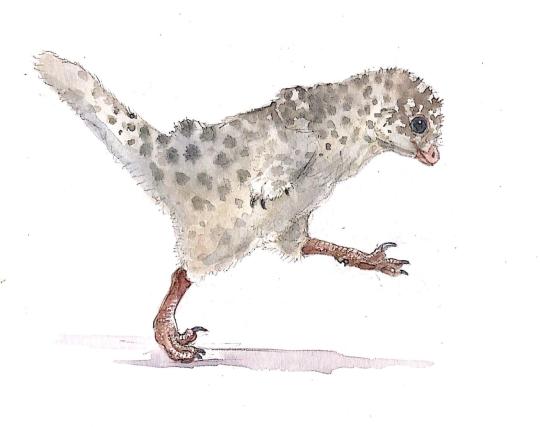
By Ripley Cook
Etymology: Byron’s Reptile
First Described By: Norell, Makovicky, & Clark, 2000
Classification: Dinosauromorpha, Dinosauriformes, Dracohors, Dinosauria, Saurischia, Eusaurischia, Theropoda, Neotheropoda, Averostra, Tetanurae, Orionides, Avetheropoda, Coelurosauria, Tyrannoraptora, Maniraptoriformes, Maniraptora, Pennaraptora, Paraves, Eumaniraptora, Troodontidae, Troodontinae
Status: Extinct
Time and Place: Between 78 and 75 million years ago, in the Campanian of the Late Cretaceous


Byronosaurus is known from the Ukhaa Tolgod of the Djadokhta Formation in Mongolia
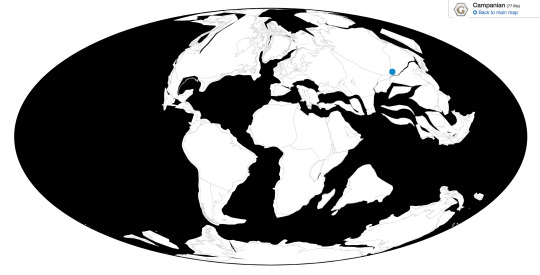
Physical Description: Byronosaurus was a Troodontid, a type of slender almost-bird with the same sickle-shaped claws as the famous Raptors, but much smaller and built more for trapping food than strategic stabbing. Like other members of the group, Byronosaurus was fairly small, slender, with large wings and skinny legs 0 it only reached about 1.5 meters in length, and 50 centimeters in height, weighing only 4 kilograms. It had a long, narrow snout attached to a decently sized neck. Its tail was also long, ending in a tail fan. Like other Troodontids, it had very closely-spaced together teeth, and a lot of them to boot. These were non-serrated teeth, which is weird for a Troodontid. It was also extremely intelligent - Troodontids had some of the larger brains for their body size of dinosaurs at the time. It would have been very fluffy indeed. We also have babies of Byronosaurus, which were either just hatched or about to hatch; they had big eyes, like most babies, and in general “cute” features.
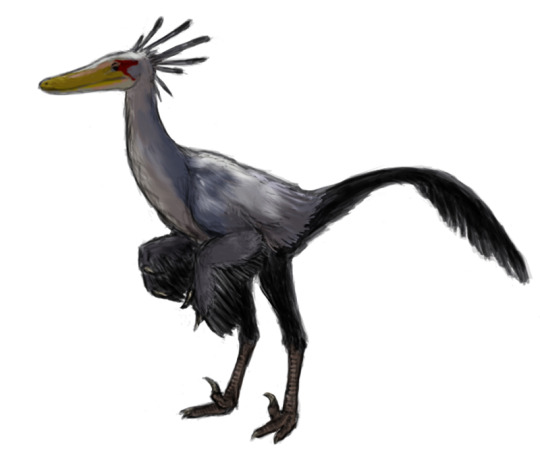
By Michael B. H., CC BY-SA 3.0
Diet: Byronosaurus would have fed on a variety of small animals such as mammals, lizards, and baby dinosaurs.
Behavior: Byronosaurus would have been a fairly active and skittish animal, attempting to dodge predators and larger dinosaurs while still finding food. It probably would have ducked in between and around shrubs and other brittle desert plants, looking for its prey. It then could have darted into the brush, grabbed the food, and pinned it down using its feet. It probably didn’t engage much in raptor-prey-restraint flapping, though it could have if it needed to; though it likely did engage in wing-assisted-inclined-running, using powerful flaps and its light weight to run up vertical surfaces such as cliffs. It probably used its wings and tail fan for display, fluffing them out and extending them to talk to other Byronosaurus. They also would have looked distinctly different from other feathery dinosaurs in the area, using color and patterns to stand out amongst their cousins. As a desert animal, it also probably would have tried to conserve its energy wherever it could, hiding in places of shade. Byronosaurus took care of its young, and its possible that they did so in family groups.
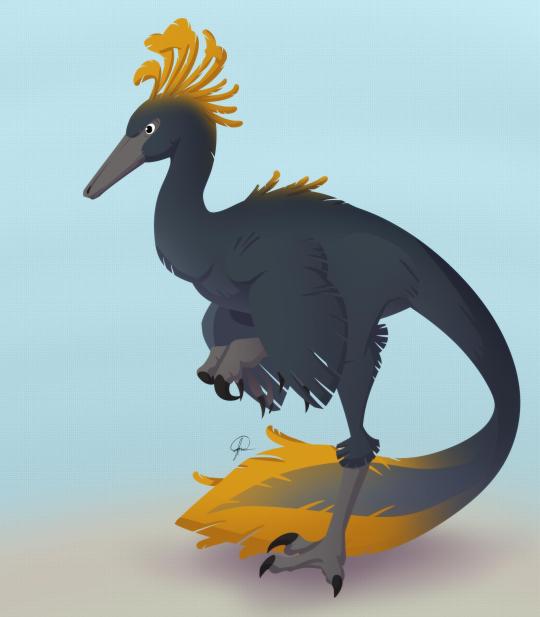
By José Carlos Cortés
Ecosystem: The Djadochta Formation was an arid desert, with red sand and dirt for miles around. This red coloration of the ground gave it the famous name “Flaming Cliffs,” and probably would have made most dinosaurs in the area actually quite red themselves, in order to blend in. Freshwater here was present - enough to have freshwater-adapted animals - but rare, only taking the form of oases and arroyos. No plant fossils are known, but they would have likely been dry shrubs and other arid-adapted plants. Here, Byronosaurus shared its environment with an innumerable variety of dinosaurs - ankylosaurs like Pinacosaurus, ceratopsians like Protoceratops, Alvarezsaurs like Kol and Shuvuuia, Oviraptorosaurs like Citipati and Khaan, Dromaeosaurs like Halszkaraptor and Velociraptor and Acheroraptor, other Troodontids like Almas, Opposite Birds like Gobipteryx, and True Birds like Apsaravis. Non-dinosaurs were present in droves too - there were Crocodylomorphs like Shamosuchus and Zaraasuchus, lizards aplenty from Slavoia to Isodontosaurus to Parmeosaurus to Mimeosaurus to Adamisaurus, turtles like Zangerlia, and a lot of small mammals like Deltatheridium and Maelestes and Zalambdalestes and Bulganbaatar and Kryptobaatar. Ultimately, lizards grew like weeds in the Djadochta, and would have been the primary source of food for Byronosaurus. Interesting enough, Byronosaurus may have had its eggs stolen and eaten by - or it parasitized the nests of - Citipati.
Other: Byronosaurus is one of many theropods known from the Djadokhta Formation, a place that is weirdly theropod heavy (and, at that, fluffy theropod heavy). It is known from multiple specimens, and is closely related to the Troodontines of North America.
~ By Meig Dickson
Sources under the Cut
Bever, G.S. and Norell, M.A. (2009). "The perinate skull of Byronosaurus (Troodontidae) with observations on the cranial ontogeny of paravian theropods." American Museum Novitates, 3657: 51.
Cau, A.; Beyrand, V.; Voeten, D.; Fernandez, V.; Tafforeau, P.; Stein, K.; Barsbold, R.; Tsogtbaatar, K.; Currie, P.; Godefroit, P. (2017). "Synchrotron scanning reveals amphibious ecomorphology in a new clade of bird-like dinosaurs". Nature.
Chinzorig Tsogtbaatar; Yoshitsugu Kobayashi; Tsogtbaatar Khishigjav; Philip J. Currie; Mahito Watabe; Barsbold Rinchen (2017). "First Ornithomimid (Theropoda, Ornithomimosauria) from the Upper Cretaceous Djadokhta Formation of Tögrögiin Shiree, Mongolia". Scientific Reports. 7: Article number 5835.
Clarke, Julia A., Norell, Mark A. (2002). "The morphology and phylogenetic position of Apsaravis ukhaana from the Late Cretaceous of Mongolia". American Museum Novitates, No. 3387, American Museum of Natural History, New York, NY.
Godefroit, Pascal; Currie, Philip J.; Li, Hong; Shang, Chang Yong; Dong, Zhi-ming (2008). "A new species of Velociraptor (Dinosauria: Dromaeosauridae) from the Upper Cretaceous of northern China". Journal of Vertebrate Paleontology. 28 (2): 432–438.
Hartman, S., M. Mortimer, W. R. Wahl, D. R. Lomax, J. Lippincott, D. M. Lovelace. 2019. A new paravian dinosaur from the Late Jurassic of North America supports a late acquisition of avian flight. PeerJ: e7247.
Junchang Lü; Li Xu; Yongqing Liu; Xingliao Zhang; Songhai Jia & Qiang Ji (2010). "A new troodontid (Theropoda: Troodontidae) from the Late Cretaceous of central China, and the radiation of Asian troodontids". Acta Palaeontologica Polonica. 55 (3): 381–388.
Ksepka, Daniel T.; Norell, Mark A. (2004). "Ornithomimosauria cranial material from Ukhaa Tolgod (Omnogov, Mongolia)". American Museum Novitates. 3448: 1–4.
Longrich, Nicholas R.; Philip J. Currie; Dong Zhi-Ming (2010). "A new oviraptorid (Dinosauria: Theropoda) from the Upper Cretaceous of Bayan Mandahu, Inner Mongolia". Palaeontology. 53 (5): 945–960.
Makovicky, P.J.; Norell, M.A.; Clark, J.M.; Rowe, T.E. (2003). "Osteology and relationships of Byronosaurus jaffei (Theropoda: Troodontidae)". American Museum Novitates. 3402: 1–32.
Mackovicky, Peter J.; Norell, Mark A. (2004). "Troodontidae". In Weishampel, David B.; Dodson, Peter; Osmólska, Halszka (eds.). The Dinosauria (2nd ed.). Berkeley: University of California Press. pp. 184–195.
Montague, R. (2006). "Estimates of body size and geological time of origin for 612 dinosaur genera (Saurischia, Ornithischia)". Florida Scientist. 69 (4): 243–257.
Norell, Mark A.; Clark, James M.; Dashzeveg, Demberelyin; Barsbold, Rhinchen; Chiappe, Luis M.; Davidson, Amy R.; McKenna, Malcolm C.; Perle, Altangerel; Novacek, Michael J. (November 4, 1994). "A theropod dinosaur embryo and the affinities of the Flaming Cliffs dinosaur eggs". Science. 266 (5186): 779–782.
Norell, M.A.; Clark, J.M.; Turner, A.H.; Makovicky, P.J.; Barsbold, R.; Rowe, T. (2006). "A new dromaeosaurid theropod from Ukhaa Tolgod (Omnogov, Mongolia)". American Museum Novitates. 3545: 1–51.
Norell, M.A., Makovicky, P.J. & Clark, J.M., 2000, "A new troodontid theropod from Ukhaa Tolgod, Mongolia", Journal of Vertebrate Paleontology 20(1): 7-11
Novacek, M.J., Norell, M.A, McKenna, M.C. and Clark, J.M, 1994, "Fossils of the Flaming Cliffs", Scientific American 271(6), 60-69
Pei, R.; Norell, M.A.; Barta, D.E; Bever, G.S.; Pittman, M.; Xu, Xing (2017). "Osteology of a New Late Cretaceous Troodontid Specimen from Ukhaa Tolgod, Ömnögovi Aimag, Mongolia". American Museum Novitates (3889): 1–47
Tsuihiji, T.; Barsbold, R.; Watabe, M.; Tsogtbaatar, K.; Chinzorig, T.; Fujiyama, Y.; Suzuki, S. (2014). "An exquisitely preserved troodontid theropod with new information on the palatal structure from the Upper Cretaceous of Mongolia". Naturwissenschaften. 101: 131–142.
Turner, A.H.; Nesbitt, S.J.; Norell, M.A. (2009). "A Large Alvarezsaurid from the Cretaceous of Mongolia". American Museum Novitates. 3648: 1–14.
Varricchio, D.J.; Barta, D.E. (2015). "Revisiting Sabath's "Larger Avian Eggs" from the Gobi Cretaceous". Acta Palaeontologica Polonica. 60 (1): 11–25.
Weishampel, David B.; Dodson, Peter; and Osmólska, Halszka (eds.): The Dinosauria, 2nd, Berkeley: University of California Press. 861 pp.
#Byronosaurus jaffei#Byronosaurus#Troodontid#Dinosaur#Bird#Birds#Dinosaurs#Birblr#Palaeoblr#Prehistoric Life#Paleontology#Prehistory#Maniraptoran#Feathered Dinosaurs#Cretaceous#Eurasia#Theropod Thursday#Carnivore#Factfile#biology#a dinosaur a day#a-dinosaur-a-day#dinosaur of the day#dinosaur-of-the-day#science#nature
208 notes
·
View notes